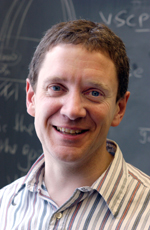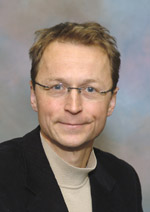
|
| Nick Bigelow (PHOTO CREDIT: University of Rochester) |
|
High-resolution photo for download (please include photo credit) |

|
| Lukas Novotny(PHOTO CREDIT: University of Rochester) |
|
High-resolution photo for download (please include photo credit) |
Innovations in research on ultra-cold atoms and antennas that collect light attracted fellowships to two University of Rochester researchers.
The Optical Society of America has named as fellows Nicholas P. Bigelow, Lee A. DuBridge Professor of Physics, professor of optics, and senior scientist at the Laboratory for Laser Energetics; and Lukas Novotny, professor of optics and physics, professor of biomedical engineering, and scientist at the Laboratory for Laser Energetics.
The Optical Society—devoted to advancing the science of light—accepts only a tenth of its thousands of members as fellows. It recognizes Bigelow and Novotny for pioneering research as well as contributions to the scientific community.
Bigelow is an experimental leader in both spin squeezing and two-species trapping of ultra-cold atoms. His team researches in the counter-intuitive arena of using light to cool atoms. The researchers isolate small clouds of atoms from the surrounding environment in a chamber that maintains pressure lower than found almost anywhere else in the solar system. The team precisely cools atoms to the millionths and even billionths of a degree above absolute zero by slowing their movement and nudging the process a step further using evaporation.
Bigelow's research in spin squeezing involves an area of quantum mechanics known as entanglement. Based on ideas with roots in mathematics and noise theory, his group used light to induce the atoms in an atomic vapor to synchronize in a unique way that dramatically eliminated noise in atomic measurements, measurements such as are found in an atomic clock. More recently, Bigelow's group has been involved in creating nano-sized versions of his atomic wave experiments, using a nano-structured silicon wafer dubbed "the atom chip."
Novotny's fellowship recognizes pioneering contributions to the field of nano-scale spectroscopy. His team explores how antenna theory works at optical frequencies, frequencies where metals behave as strongly coupled plasmas. The team fabricates optical antennas that concentrate and redirect light, working in the unexplained territory between microscopic and macroscopic. Optical antennas are able to strongly concentrate light, thereby creating nanoscale light sources for optical microscopy. By guiding these light sources over the surface of an object, Novotny's team is able to achieve unprecedented optical resolution and see ultrasmall details such as single molecules and defects in carbon nanotubes.
Novotny's ongoing research focuses in part on finding the sweet spot where an optical antenna is close enough to a molecule to attract its energy, but not so close that the energy is completely absorbed.
Bigelow has given service through meeting organization and journal editing, and Novotny through leadership in the community of near-field optics. Bigelow is active in the Rochester Quantum Information Center, the University of Rochester's Materials Science Program, and the Rochester Theory Center for Optical Science and Engineering.
Novotny is head of the Center for Nanoscale Subsurface Spectroscopy and Tomography, and is the author of Principles of Nano-Optics, published by Cambridge University Press.
